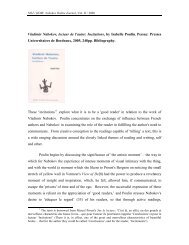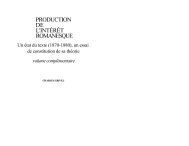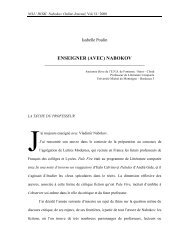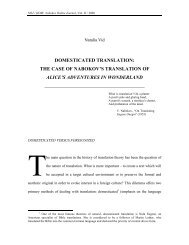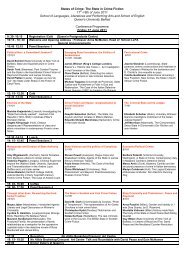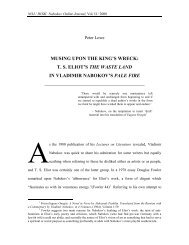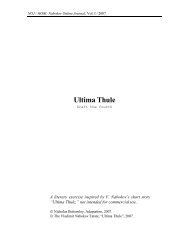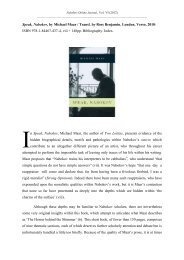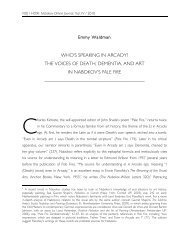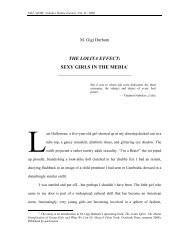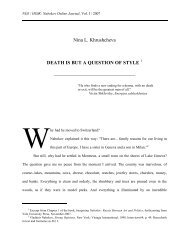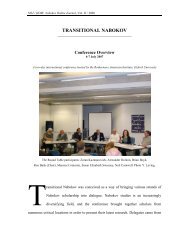Create successful ePaper yourself
Turn your PDF publications into a flip-book with our unique Google optimized e-Paper software.
genre, for example, is a happy ending, which Nabokov was certainly unwilling to provide,<br />
feeling that he needed to shroud the dramatic finale of Lolita in a cloud of ambiguity and “black<br />
humor.” Several of these authorial strategies had been successfully dealt with and tested by Ilf<br />
and Petrov, whose novels enjoyed immense popularity in the Soviet Union (especially with<br />
younger readers) in spite of being blasphemously critical of the Soviet regime.<br />
There are numerous allusions to Ilf and Petrov’s novels in the text of Lolita. For example,<br />
Humbert’s way of addressing the “Gentlemen and Gentlewomen of the Jury” is clearly borrowed<br />
from The Golden Calf, in which the protagonist Ostap uses exactly the same way of addressing<br />
the imaginary audience as he blackmails an underground Soviet millionaire into sharing one of<br />
his millions with the Ostap-led gang of adventurers. Besides, the overall tone of playfulness and<br />
“black humor” of Humbert’s confessions may have been prompted by Ilf and Petrov’s venomous<br />
irony toward nearly everything in the Soviet socio-cultural landscape. Most strikingly, as Lem<br />
notes, Humbert’s laughter is aimed at something no one else before him was able to ridicule so<br />
effortlessly – his own lust and concupiscence. 11 Bender is similarly ironic about his own sexual<br />
impulses in both novels. But it seems to me that the most conspicuous parallel between Lolita<br />
and Twelve Chairs is the fact that the character of the widow Haze is, perhaps, modeled in part<br />
upon that of the widow Gritsatsuyeva.<br />
Ostap Bender’s idea of marrying the widow to get hold of her several chairs, inside which<br />
the diamonds may have been hidden, is similar to Humbert’s cold-blooded consent to wed the<br />
“Haze woman” hoping that the minor inconvenience of a convenience marriage would allow him<br />
to be closer to the object of his passion, Charlotte’s longed-for daughter. Resemblances between<br />
Gritsatsuyeva and Charlotte are numerous. Both women can be qualified as знойная женщина,<br />
мечта поэта / “a passionate woman, a poet’s dream” (Ilf & Petrov 1928, 181); they look<br />
11 Lem thinks that this ubiquitous irony is what differs Nabokov from Dostoevsky. His example of the lustful that<br />
Nabokov’s H.H. turns into the ludicrous is his daydreams about leaving the school in Beardsley with Lolita, crossing<br />
the Mexican border and “lying low” with her for several years before he could legally marry her. He is concerned<br />
that her “nymphage” would then end as she comes of age but quickly finds the solution:<br />
With patience and luck I might have her produce eventually a nymphet with my blood in her<br />
exquisite veins, a Lolita the second, who would be eight or nine around 1960, when I would still<br />
be dans la force de l’âge…a vieillard encore vert… bizarre, tender, salivating Dr. Humbert,<br />
practicing on supremely lovely Lolita the Third the art of being a granddad (Nabokov 1970, 173-<br />
174).<br />
Lem emphasizes the fact that the filthiness and cynicism of these dreams borders on the comical and humorous,<br />
allowing Humbert to get away with his “priapic super-optimism” (Lem 1962).<br />
10



